
HOME
INTRO
SYMBOLS
ALMANAC
ECONOMY
GEOGRAPHY
STATE MAPS
PEOPLE
FORUM
NEWS
COOL SCHOOLS
STATE QUIZ
STATE LINKS
BOOK STORE
MARKETPLACE
GUESTBOOK
CONTACT US


You may double left-click on a word on this page to retrieve its definition. Tweet Follow
New Mexico State Tree
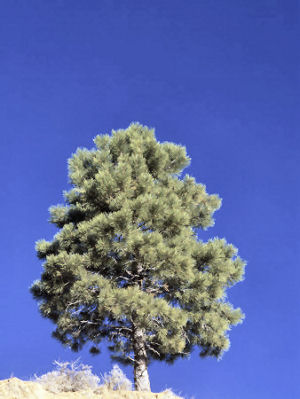
New Mexico State Tree: Nut Pine or Pinon Tree
Photographs, prints, posters
Asked to select an official state tree for the state, the New Mexico Federation of Women's Clubs ran a series of contests to narrow the field. In the end, they chose the nut pine or pinon tree (Pinus edulis) most often referred to in symbol lists as the pinon pine. The quaking aspen, adopted in 2014 as Utah's state tree, was runner-up to the nut pine.
Pinus edulis was chosen by the New Mexico Federation of Women's Clubs for historical reasons. Evidence of the use of the tree for fuel and it's nuts (seeds) for food go back to pre-historic times.
Charred wood from the pinon has been found by archaeologists examining buried campfires that burned centuries before the first Spanish conquerors claimed New Mexico in the 16th Century. Logs from the hardy pinon have been discovered still supporting roofs of pre-historic pit-house dwellers.
The Spanish general, Coronado, who explored New Mexico in 1540-42 told of the "pine nuts" stored by the Indians for the winter. The early colonists burned pinon logs in their fireplaces, as many New Mexicans do today, and felt that no wood compared with it in terms of heat and fragrance.
Navajo Indians harvest tons of pinon nuts ever Autumn, and the roasted nuts are sold not only in New Mexico but in all major American cities, where they are considered great delicacies. Wild deer hat have fed on pinon nuts are considered by New Mexico's sportsmen to produce better venison than deer the browse on other plants.
("State Tree of New Mexico Comes Into Its Own In Winter Season", 1957)
The legislation, House Bill No. 108, was adopted by the legislature as the official state tree of New Mexico on March 16, 1949. Approval of the bill also brought New Mexico an official state bird.
Some news accounts at the time also credited House Bill No. 108 with making the yucca the official state flower, but the New Mexico state flower was actually adopted in 1927.
We have, as yet, been unable to determine when the legislation was signed into law by Governor Thomas J. Mabry or, for that matter, whether he signed it at all.
Pinus edulis is also known as the Colorado pinyon, pinyon pine, Rocky Mountain pinyon, and two-needle pinyon.
It's the only member of the pine family that provides edible nuts.
In 1959 the State of Nevada adopted the Single-leaf pinon as an official state tree.
New Mexico Law

Pine nuts
Photographs, prints, posters
The following information was excerpted from the New Mexico Public Access Law ? Statutes and Court Rules (unannotated), Chapter 12, Article 3, Section 12-3-4.
CHAPTER 12 Miscellaneous Public Affairs Matters
ARTICLE 3 State Seal, Song and Symbols
Section 12-3-4
12-3-4. State flower; state bird; state tree; state fish; state animal; state vegetables; state gem; state grass; state fossil; state cookie; state insect; state question; state answer; state nickname; state butterfly; state reptile; state amphibian; state aircraft; state historic railroad; state tie; state necklace.
A. The yucca flower is adopted as the official flower of New Mexico.
B. The chaparral bird, commonly called roadrunner, is adopted as the official bird of New Mexico.
C. The nut pine or pinon tree, scientifically known as Pinus edulis, is adopted as the official tree of New Mexico.
D. The native New Mexico cutthroat trout is adopted as the official fish of New Mexico.
E. The native New Mexico black bear is adopted as the official animal of New Mexico.
F. The chile, the Spanish adaptation of the chilli, and the pinto bean, commonly known as the frijol, are adopted as the official vegetables of New Mexico.
G. The turquoise is adopted as the official gem of New Mexico.
H. The blue grama grass, scientifically known as Bouteloua gracillis, is adopted as the official grass of New Mexico.
I. The coelophysis is adopted as the official fossil of New Mexico.
J. The bizcochito is adopted as the official cookie of New Mexico.
K. The tarantula hawk wasp, scientifically known as Pepsis formosa, is adopted as the official insect of New Mexico.
L. "Red or green?" is adopted as the official question of New Mexico.
M. "Red and green or Christmas" is adopted as the official answer of New Mexico.
N. "The Land of Enchantment" is adopted as the official nickname of New Mexico.
O. The Sandia hairstreak is adopted as the official butterfly of New Mexico.
P. The New Mexico whiptail lizard, scientifically known as Cnemidophorus neomexicanus, is adopted as the official reptile of New Mexico.
Q. The New Mexico spadefoot toad, scientifically known as Spea multiplicata, is adopted as the official amphibian of New Mexico.
R. The hot air balloon is adopted as the official aircraft of New Mexico.
S. The Cumbres and Toltec scenic railroad is adopted as the official historic railroad of New Mexico.
T. The bolo tie is adopted as the official tie of New Mexico.
U. The Native American squash blossom necklace is adopted as the official necklace of New Mexico.
History: Laws 1927, ch. 102, § 1; C.S. 1929, § 129-101; 1941 Comp., § 3-1303; Laws 1949, ch. 142, § 1; 1953 Comp., § 4-14-3; Laws 1955, ch. 245, § 1; 1963, ch. 2, § 1; 1965, ch. 20, § 1; 1967, ch. 51, § 1; 1967, ch. 118, § 1; 1973, ch. 95, § 1; 1981, ch. 123, § 1; 1989, ch. 8, § 1; 1989, ch. 154, § 1; 1999, ch. 266, § 1; 1999, ch. 271, § 1; 2003, ch. 182, § 1; 2005, ch. 4, § 1; 2005, ch. 254, § 1; 2007, ch. 10, § 1; 2007, ch. 179, § 1; 2011, ch. 52, § 1.
Sources...
"Constitutional Convention Defeated in Committee." Albuquerque Journal 1 Mar. 1949: 2. Print.
"New Mexico Public Access Law ? Statutes and Court Rules (unannotated)." New Mexico State Legislature, 31 Dec. 2013. Web. 13 June 2014. .
New Mexico State Legislature Handbook. ed. Santa Fe: New Mexico State Legislature, 2005. Print.
Shearer, Benjamin F. and Barbara S. State Names, Seals, Flags and Symbols: A Historical Guide Third Edition, Revised and Expanded. Westport, Conn: Greenwood Press, 3 Sub edition, 2001.
"State Tree of New Mexico Comes Into Its Own In Winter Season." Las Cruces Sun-News 9 Dec. 1957: 2. Print.
Additional Information

New Mexico State Tree: Nut Pine or Pinon Tree
Photographs, prints, posters
State Tree: New Mexico Office of the Secretary of State.
pinyon pine, Pinaceae Pinus edulis Engelm.: Virginia Tech Department of Forest Resources and Environmental Conservation.
Pinus edulis Engelm. (Pinyon): United States Department of Agriculture (USDA) Forest Service: Silvics of North America.
Pinus edulis Engelm. (twoneedle pinyon): USDA, NRCS. 2016. The PLANTS Database (http://plants.usda.gov). National Plant Data Center, Baton Rouge, LA 70874-4490 USA.
Pinus edulis Engelm.: Integrated Taxonomic Information System (ITIS).
Pinus edulis - Engelm.: Plants For A Future (PFAF): researching and providing information on ecologically sustainable horticulture.
Pinus edulis Engelm.: Images from CalPhotos Photo Database.
Pinus edulis: Search for images of Pinus edulis with Google.
State trees: Complete list of official state trees from NETSTATE.COM.
More symbols & emblems: Complete list of official New Mexico state symbols from NETSTATE.COM.
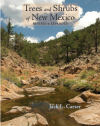
Trees and Shrubs
of New Mexico
Jack L. Carter
Trees and Shrubs of New Mexico, by Jack L. Carter. 524 pages. Publisher: Mimbres Press (2012)
Trees and Shrubs of New Mexico is designed for use by both interested laypersons and plant scientists. It includes more than 500 full-color photos and 450 finely detailed illustrations by Marjorie Leggitt and descriptions of more than 490 naturalized and cultivated trees, shrubs and woody vines that are known to occur in New Mexico, as well as distribution maps and dichotomous keys. The guide is designed to assist the educated layperson interested in identifying New Mexico flora, says Carter, who now lives in Silver City, N.M.
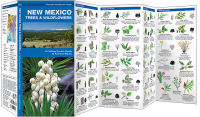
New Mexico
Trees & Wildflowers
James Kavanagh
New Mexico Trees & Wildflowers: A Folding Pocket Guide to Familiar Species, by James Kavanagh. Folding pamphlet. Publisher: Waterford Press; Laminated Chart edition (April 1, 2010)
The "Land of Enchantment" lives up to its name during wildflower season. The state flower - the yucca - is one of thousands of species of plants growing in the diverse ecosystems found throughout the state. This beautifully illustrated guide highlights over 140 familiar and unique species of trees, shrubs and wildflowers. It also includes a map featuring prominent botanical sanctuaries that every nature enthusiast should explore. Laminated for durability, this lightweight, pocket-sized folding guide is an excellent source of portable information and ideal for field use by visitors and residents alike.
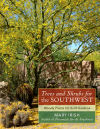
Trees and Shrubs
for the Southwest
Mary Irish
Trees and Shrubs for the Southwest: Woody Plants for Arid Gardens, by Mary Irish. 332 pages. Publisher: Timber Press (November 12, 2008)
Like gardeners everywhere, gardeners in the Southwest want home landscapes that include lush, thriving trees and shrubs. But contending with difficult soils, three-digit summer temperatures, and minimal rainfall can pose a daunting challenge. To add to the dilemma, many plants that prosper in other parts of the country can't be grown in the Southwest without resorting to wasteful artificial irrigation. The solution to this conundrum is choosing plants that are adapted to the rigors of the southwestern climate.
In Trees and Shrubs for the Southwest, readers will find profiles of more than 200 of the most attractive, easy-to-grow, and climate appropriate trees and shrubs. Mary Irish also provides expert information about how to use trees and shrubs in the garden, how to plant and care for them, and how to combat common pests and diseases. This comprehensive title also includes clear and concise instructions on common tasks such as planting, staking, and pruning. From feathery-leaved acacias to bright-flowered desert willows, tough-as-nails mesquites to silvery Texas rangers, homeowners who want to create an attractive, sustainable landscape will find no better resource.
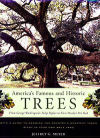
America's Famous
and Historic Trees
Jeffrey G. Meyer
America's Famous and Historic Trees: From George Washington's Tulip Poplar to Elvis Presley's Pin Oak
by Jeffrey G. Meyer. 130 pages. Houghton Mifflin Harcourt; First Edition (April 20, 2001)
America's Famous and Historic Trees tells the stories of various trees that Meyer and his cohorts rescued or propagated: oftentimes, when trees were going to be cut down, he and his workers headed off the bulldozers, rescuing the tree with their massive tree hoe. Other trees--like the Indian Marker Pecan in southeast Dallas--were propagated before they died.
Trees : National Champions
by Barbara Bosworth. 144 pages. The MIT Press; First Edition (August 19, 2005)
Bosworth captures the ineffable grace and dignity of trees with clarity and directness: the green ash that shades a Midwestern crossroads, the common pear that blooms in a Washington field, and the Florida strangler fig with its mass of entwining aerial roots. Her black and white photographs, panoramic views taken with an 8 x 10 camera, show the immensity of the largest species and the hidden triumphs of the smallest
Plants, Seeds & Flowers: Bulbs, seeds, plants, fertilizer, plant containers and more.
Gardening Tools: Pruners, rakes, shovels, hoes, trowels, cultivators and tillers, greenhouses, yard carts and more.

